|
Builder: Aeolian-Skinner Opus: 892, 892A, 892B, 892C Manuals: IV Stops: 81 Pipes: 6975 Ranks: 108 Action: Electro-Pneumatic Year: 1932-1935 --Information from Dean Billmeyer, Mike Foley, Laura Edman, Charles Hendrickson and David Engen. Foley-Baker, Inc. removed the Northrop Organ and placed it in storage on campus. Northrop Auditorium was down-sized from a 4800 seat room to a 2800 seat room. There are three balconies rather than the original one. The organ chambers originally above the stage have been reconstructed. Instead of two levels there is one, with the pedal moved to chambers flanking the sides of the stage. The thick plaster grill through which the organ spoke into the vast hall has been removed so sound egress into the room is direct. Completed restoration planned for 2018, with no tonal changes. Since the organ was installed under four contracts, begun by Skinner and completed by Harrison, it is interesting to note the change in materials during this time. The earliest Great 8' diapasons are lead and the late ones are spotted metal. -- Last update 05/31/2017 |
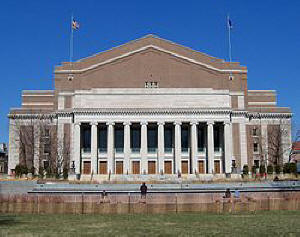 |
|
|
Pre renovation: Northrop Auditorium was completed in 1930, and the organ was installed in four stages between 1932 and 1935 as funds became available. There is virtually no reverberation in the 4800-seat auditorium. The organ is installed in the upper center of the proscenium shell and the console is located on a lift in the front-center of the orchestra pit seventy feet below and behind the proscenium. The organ is best heard in the balcony. It was designed by Ernest Skinner but installed and finished by G. Donald Harrison. The organ almost died a couple of times but has been lovingly cared for by Gordon Schultz, who has kept the organ operational since the 1970s. Housed in the ceiling of the auditorium, above the stage and behind the proscenium, the organ speaks through the proscenium’s grillwork and is played from a four-manual console located in the orchestra pit. Completely unaltered, intact, and in its original condition after 75 years, the Northrop organ possesses enormous historical value and is one of the most important instruments in the Upper Midwest. |
||
|
GREAT ORGAN 16 Diapason 8 First Diapason 8 Second Diapason 8 Third Diapason 8 Flute Harmonique 8 Gedeckt 8 Viola 8 Gemshorn 5-1/3 Quint 4 Octave 4 Second Octave 4 Flute 3-1/5 Tenth 2-2/3 Twelfth 2 Fifteenth VII Plein Jeu IV Harmonics (includes tierce, 7th) 16 Contra Tromba 8 Tromba 4 Octave Tromba Harp Chimes Celesta |
SWELL ORGAN 16 Bourdon 16 Gemshorn 8 Geigen Diapason 8 Hohlflute 8 Rohrflute 8 Flauto Dolce 8 Flute Celeste 8 Salicional 8 Voix Celeste 8 Echo Gamba 8 Echo Celeste 4 Octave Geigen 4 Flute 4 Violina 2-2/3 Twelfth 2 Fifteenth V Dolce Cornet V Chorus Mixture 16 Posaune 8 French Trumpet 8 Cornopean 8 Oboe 8 Vox Humana 4 Clarion Tremolo Harp Celesta |
|
|
CHOIR ORGAN 16 Contra Viole 8 Diapason 8 Concert Flute 8 Cor de Nuit 8 Dulcet II 8 Dulciana 8 Unda Maris 4 Flute 4 Gemshorn 2-2/3 Nazard 2 Piccolo 1-3/5 Tierce 1-1/3 Larigot III Dulciana Mixture 16 Fagotto 8 Trumpet 8 Orchestral Oboe 8 Clarinet Tremolo Harp Celesta |
SOLO ORGAN 20" 16 Contra Gamba 8 Flauto Mirabilis 8 Gamba 8 Gamba Celeste 8 Aetherial Celeste II 4 Orchestral Flute 4 Octave Gamba III Cornet de Viole 16 Corno di Bassetto 8 English Horn 8 French Horn 8 Tuba Mirabilis 4 Tuba Clarion Tremolo Harp Celesta Chimes |
|
|
PEDAL ORGAN 32 Double Open Diapason 32 Sub Bourdon (originally started at low G; Foley-Baker completed it) 16 Diapason 16 Metal Diapason 16 Diapason (Gt) 16 Contra Basse 16 Contra Gamba (Solo) 16 Contra Viole (Ch) 16 Bourdon 16 Gemshorn (Sw) 16 Echo Lieblich (Sw) 8 Octave 8 Cello 8 Viole (Ch) 8 Gedeckt 8 Still Gedeckt (Sw) 5-1/3 Twelfth 4 Super Octave 4 Flute V Harmonics (includes tierce) 32 Bombarde 32 Contra Fagotto (Ch) 16 Trombone 16 Posaune (Sw) 16 Fagotto (Ch) 8 Tromba 4 Clarion Chimes |
||
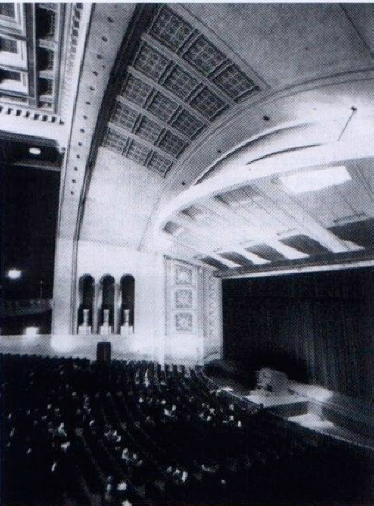 |
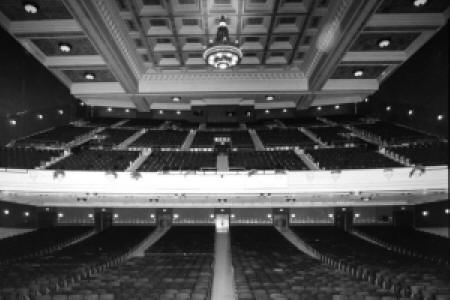 |
|
| Black and white photos show Northrop as it was until the renovations of both hall and organ. In the picture at left can be seen the ceiling grill (about 18" thick) through which the organ spoke. Stacked chambers were directly above the stage, with the sound reflected by a huge curved "tone chute". The four enclosed divisions (Swell, Choir on left, enclosed Great and Solo on right) were centered, with big pedal at the far left and the remaining pedal and Great on the right. The pedal mixture chest alone stood in front of the enclosures in the most prominent acoustic location near the opening. | ||
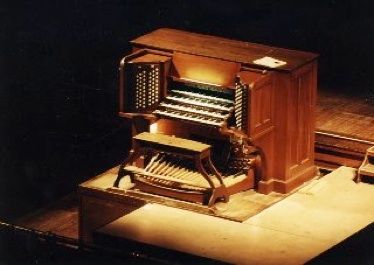 |
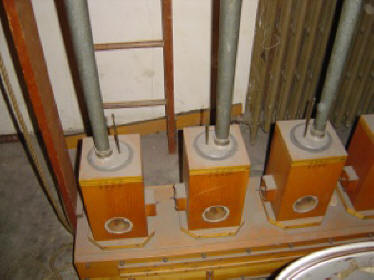 |
From before the renovation: on the left is the console on its lift. On the left is a view of 32' Bombarde boots. |
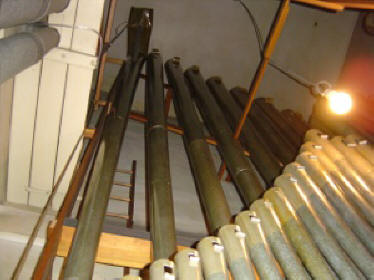 |
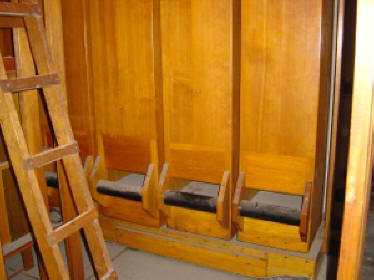 |
Only 32' C of the Bombarde required a miter. Ladder to Solo, with walkway outside the Solo chamber. On the right: 32' Open Diapason in wood, on the left side of the chamber. |
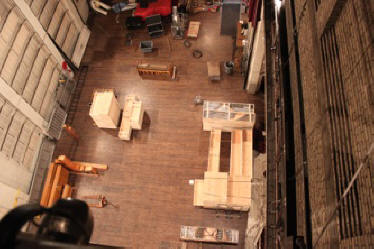 |
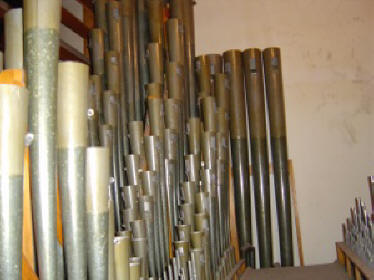 |
On the left is a view down to the stage from the chamber door through which the entire organ was removed. Right: enclosed Great Tromba chorus. (There is a cornopean chorus in the swell) |
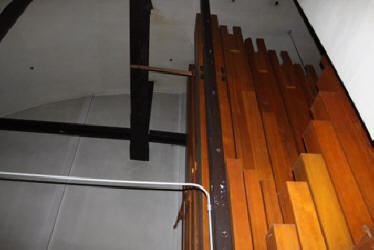 |
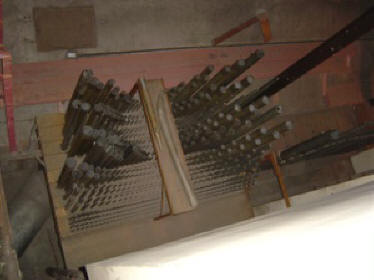 |
On left are the largest wood pedal stops. On the right is a view from the Solo chamber down to one of the exposed Great chests. The huge ceiling grill would be directly above this picture. |
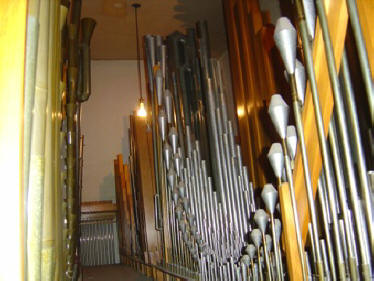 |
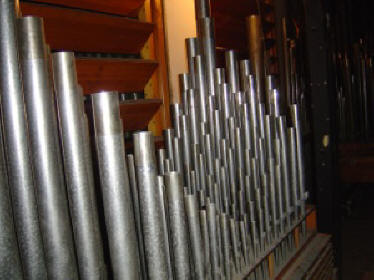 |
Left: Solo chamber, which houses four chests on two pressures. English Horn in foreground. Right is Pedal Harmonics V, which includes a tierce and seventh. |
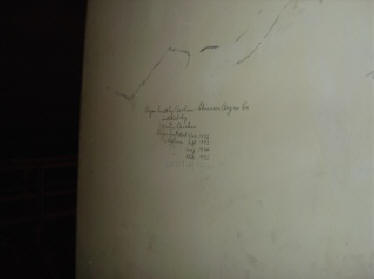 |
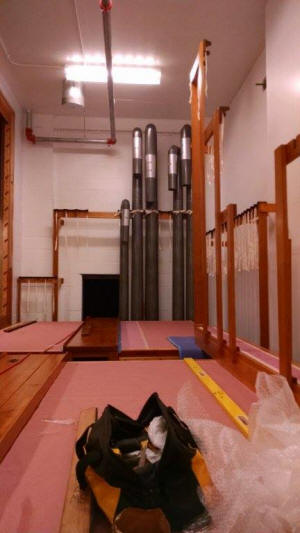 |
Left: An inscription from the original installation showing names
and dates, written on the outside of the Solo chamber. Remaining pictures are from Foley-Baker, showing various states of reconstruction and installation. Shown here is the empty Swell chamber. |
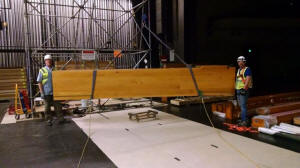 |
||
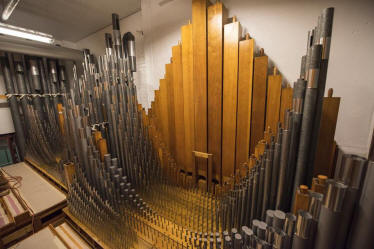 |
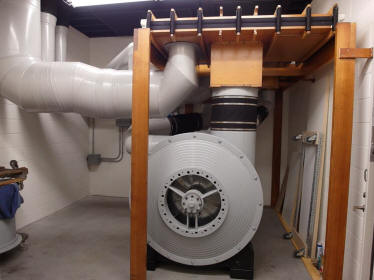 |
Left: Swell chamber partially filled with restored pipes. Right: restored blower room. |
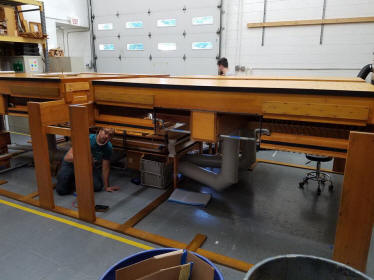 |
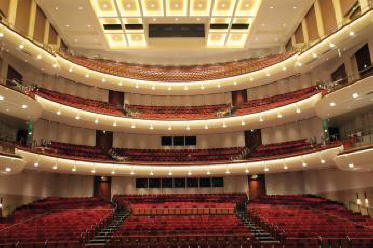 |
Left: chest set up in Foley-Baker shop. Right: completed Northrop Auditorium with reduced seating and three balconies instead of one. |
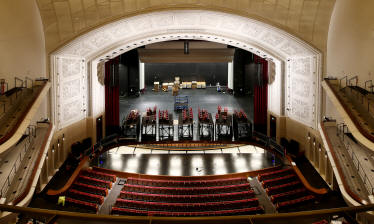 |
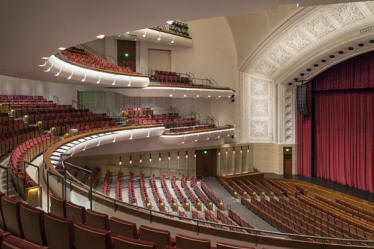 |
Other views of the revised Northrop. Only the ornate proscenium arch remains of the visible elements from the old hall. |